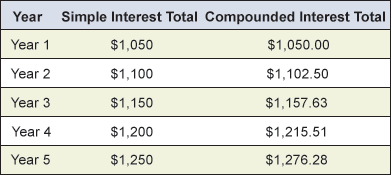
Simple and Compound Interest
(2 of 6)
Simple and Compound Interest
Perhaps you have heard of the miracle of compounding. Innumerable investors have used it to their advantage to make their money grow faster than would be the case with simple interest. The great thing about compounding is that it doesn’t require additional work on your part: you just sit back and watch your money grow. How’s that for an investment strategy?
Things To Know
- Simple interest is paid out as it is earned.
- Compound interest is interest paid on both the principal and previously earned interest.
- Compounding speeds up the growth on your balance.
Simple interest
There are two basic types of interest: simple and compound. Simple interest is the amount of interest earned on the original amount of money invested. Simple interest is paid out as it is earned and does not become part of an account’s interest-bearing balance. The invested amount is called principal. Let’s say you invest $100 (the principal) at a yearly interest rate of 5 percent. Multiplying the principal by the interest rate gives you an interest payment of $5. This is your simple interest. The next year and each year thereafter, you will be paid $5 of interest on the principal of $100.
Compound interest
Compound interest (or dividends in the case of credit unions) is interest paid on interest as well as principal. At 5 percent interest compounded annually, you will have $105 after the first year. If you keep this investment for another year, you will be paid interest on your original $100 and on the $5 you made in interest the first year. The longer you invest your money, the higher your interest payments will be, as the interest you accrue each year will be based on not only your initial investment but also the previous interest that has accumulated. This is what makes compounding interest so powerful.
With compounding, time is money
The longer an investment is allowed to compound interest, the more your balance should increase each year. In the case of compounding interest, time really is money. Let’s say you invest $1,000 for five years, with an annual interest rate of 5 percent. The difference in your investment earnings from simple and compounded interest will look like this:



